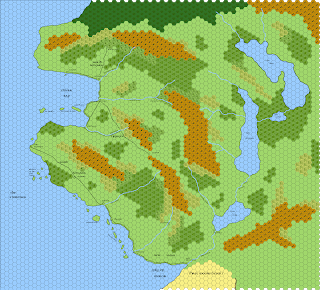As mentioned in the previous installment, I’ve filled in a lot more detail in the eastern portion of the map, and added one large and one small lake, to give the terrain some interesting features. Here’s what it looks like now (click to embiggen):
The scale is 10 miles per hex, and bear in mind that this is not the final look and feel; the final will be using the Darlene-esque look I used in my Beyond the Flanaess maps a few years ago. The map is done using Hexographer Pro, by the way.
I wanted to spend a little time considering the southernmost colony in the setting; New Valais. Named for the Kingdom of Valais far to the west across the Stormsea, I’m going for a medieval French vibe (hence the pseudo-French names).
The Duchy of New Valais stretches from the Grey River in the west to Lake Onjoi in the east. The Grey River also forms a political boundary between South Aedgaria and Lippegen, but the boundary on the other side of the mountains, in the valley where the Shining River flows, has never been firmly defined. As Lippegen continues to expand southeast in the valley, they are bound to run into conflict with the Valaisians, who are also expanding in that area. The Three Moons Desert forms the southern boundary, so named because of the time it takes to travel from one end to the other, so legend has it.
New Valais was the first colony founded, and thus the oldest. Valasian explorers were the first to arrive in Artanis once the Stormsea calmed (an event whose cause is unknown, and serves as a central mystery), allowing regular traffic across its surface. New Montrose serves as the capital and seat of the Dukedom. It is the largest settlement in Artanis, with a population of approximately 30,000.
Underneath Duke Absolon III, there are four Marquis, each based in one of the large towns; Chamlin, Anleans, Duchance, and Onjoiville. The towns have populations of between 10,000 and 15,000 each, and an equal number of peasants live in the surrounding countryside, based in small villages. The whole duchy is based on feudal land-rights, with tenant serf-farmers making up the majority of the population outside the towns.
The island chain known as the Breakers protects Chamlin and Anleans from the worst of the storms that still roll in from the Stormsea, and the coast is also connected by a fine road. No road connects Onjoiville to the rest of the Duchy, however; all traffic passes on the Firstwaterl; the river connecting Lake Onjoi and the Gulf of Morois. The Duke has granted exclusive rights to such traffic to a number of companies and families, and they guard their position (and incomes) jealously.
Chamlin is the westernmost marche in the duchy, ruled by Lewis I, Marquis d’Chamlin. They uniquely enjoy a small amount of trade with South Aedgaria, via the road that connects Chamlin and Dubton. Although this gives the Chamliners a somewhat better impression of the Aedgarians, twenty years ago they did fight a short but violent war over possession of Green Island, which is particularly fertile, not to mention strategically placed. Chamlin won the conflict, a fact which some in Dubton have not forgotten. Chamlin’s primary agricultural product is cattle and cheese. In fact, Chamlin cheese is particularly famed back home, and constitutes one of its chief high-value exports.
Anleans is another coastal marche, with a thriving fishing industry as well as large amounts of cotton, ruled by Lothar, Marquis d’Anleans. Being the interior-most marche in the duchy, Anleans is also the most secure, with few raids from orc tribes to worry about. The marquis of Chamlin and Duchance grumble about being expected to carry all the burden for the defence of Anleans, but so far the fact that the marquis is married to the duke’s second daughter has prevented any action. There are rumors that the duke is paid a special honorarium to maintain this arrangement.
Duchance is situated in a hilly valley, and the marche extends up into the hills and mountains beyond. It is ruled by Roger, marquis d’Duchance. The land is excellent for grapes and wine, which is its chief export, but suffers badly from constant raids by orcish tribes (and their goblinoid allies, originally brought over as mercenaries by Valais, but many thousands have deserted).
Onjoi is the easternmost marche, with the marquis’ residence in Onjoiville, overseen by Welois, Marquis d’Onjoi. In theory, the marquis rules over all the lands within thirty miles of Lake Onjoi, as well as the entire Shining River valley. In reality, the only really secure settlements are on the southern end of the lake, and Lippegen is beginning to settle the valley en masse. Orcs and other threats have kept Onjoi from gaining true control over the lands he has been granted, and rumors in the court of both the duke nearby and the king across the Stormsea say that patience is growing thin among his superiors. Action to secure and pacify his lands is not only expected, but required, if he is to retain his position. This has made him understandably frantic to do just that.
As mentioned before, religiously Valais and its colony follow the druidic faith. Since rangers use druid spells, they are implicitly associated with that faith. So, class-wise, there aren’t going to be any Valasian paladins or clerics, but druids and rangers will come from here.









